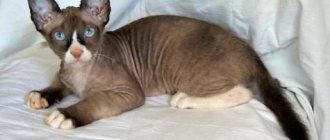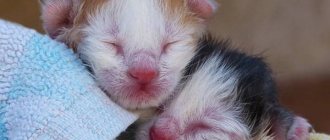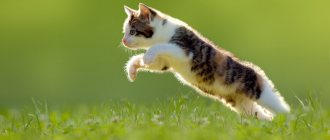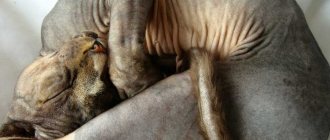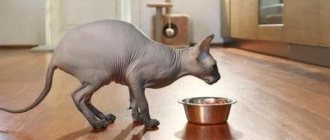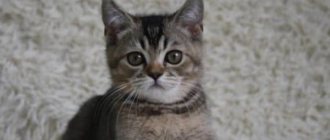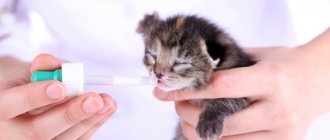The Don Sphynx is a “greenhouse” and whimsical, inquisitive, affectionate, wise and sensitive creature. As a typical bald representative of the cat world, he will make a strong impression on everyone. But whether it will be positive or with a slight admixture of hostility is a big question.
Not everyone will like a pet with an original appearance that follows its owner around. The animal will wait for the right moment to jump on your lap and receive a portion of affection. But for those who treat the totality of his quirks with understanding, the Don cat will give a lot of happiness and love.
What does the Canadian Sphynx look like?
The general impression made by the sphinxes is deceptive. The illusory weightlessness created by the absence of fur collapses the moment the animal is picked up. A tightly built body is covered in muscles, and muscles are always heavier than fat. Therefore, in the photo, the Canadian Sphynx may seem deceptively fragile.
Muzzle
What does a Canadian Sfinsky look like from different angles? The breed is characterized by a wedge-shaped head. Its width is slightly shorter than its length. The short muzzle is covered with pronounced folds. On well-developed whisker pads, the vibrissae are absent or grow to a short length. The Sphinx has high cheekbones and a strong chin. The transition from a flat forehead to a short nose is weakly expressed.
Huge ears with a wide base are the hallmark of the breed. There is a slight difference in the TICA and CFA standards that determine what the Sphynx looks like. The first organization allows a small amount of hair on the outside of the ears, and the second considers it a breed defect. Fur inside the ears is unacceptable under both standards.
The shape of the large and slightly slanted eyes resembles a lemon. They are widened towards the center and narrowed at the edges. The color of the iris should be in harmony with the color of the coat.
Body type
The head is located on a slightly arched neck of medium length. The body of the Sphinx is heavy and muscular. The muscles of cats are more developed than those of cats. The areas of the croup, abdomen and chest are rounded. The belly resembles a barrel, so it seems that the cat has recently eaten. There should be no fat deposits.
The hind limbs are longer than the front limbs, so the line of the back behind the shoulder blades is raised. The paws have an oval shape and thick pads with long and graceful toes. The fingers are well developed, so cats can open doors or take small objects into them. The animal's tail resembles a rat's. It is long and flexible, and its tapered tip allows for a small amount of hair.
Coat and color
Cats have thick and folded skin. The greatest number of folds is found on the limbs and muzzle. Instead of the classic guard hair and undercoat, soft and short fluff grows on the body. Its length does not exceed 2 mm. The tail, scrotum, outer side of the ears and the interdigital space are covered with short and sparse hair.
The coat feels like suede or velor to the touch. Hairlessness is only visible, so the standard allows any colors of the Canadian Sphynx, except shaded and zonal: smoky, chinchilla, cameo and others. Also, shorn animals are not allowed to participate in the exhibition.
Varieties of the Canadian Sphynx are the St. Petersburg and Don Sphynxes. Recently, in some countries they are considered separate breeds.
Colors
- black (nose black, like paw pads, skin slate gray);
- blue (light blue skin color with a silver tint, slate-colored nose, light gray paws);
- chocolate (nose and skin - all shades of chocolate, paw pads pinkish);
- lilac (silver with pale pink skin, nose and paws);
- white;
- cream (shades of pink);
- red (pink to bright red).
Bicolor: Any of the above with pure white. In this case, one ear should be painted over, preferably a bright spot on the top of the head.
Van: the cat is white, the tail is colored, there is a bright spot on the head that extends to the ears. The paws and nose are pale pink.
In the photo there are cats of the Canadian Sphynx breed, van and bicolor colors
Harlequin: a cross between a van and a bicolor. There is a spot on the top of the head, an ear catcher, a few spots on the body, and speckles on the legs and tail are allowed. Pink paw pads and nose.
Siamese color (color point): cream point, seal point, chocolate point, lynx point (tabby).
In the photo there is a cat of the Canadian Sphynx breed, Siamese color and harlequin
The character of the Canadian Sphynx
The Arabs called the Egyptian sphinx the Father of Terror, but the Canadian cat took only the name from the ancient sculpture. Unlike a lion with a human head, bald animals are kindness itself. The devoted nature of the Canadian Sphynx is reminiscent of a dog.
Sphinxes have an intolerant attitude towards loneliness. They become attached not to a place, but to a person. The owner's long absence makes them depressed. These animals have a hard time with family changes, so weigh the pros and cons before getting a kitten.
At home, “Canadians” do not leave their owner’s side and love to lie in his arms. These cats are friendly and highly active. They quickly find contact with children of any age. A small child will be safe with this mischievous pet, since aggression is alien to the cat. If you are often absent from work, then find company for the sphinx. They get along well with other animals and do not have hunting habits. Any pet is suitable as a playmate: another cat, dog, bird or rodent.
The breed is characterized by high intelligence, so buy some interactive toys and try training. Sphinxes are open to communication, so they are not afraid of large crowds of strangers.
Thanks to their equanimity, they give good results at exhibitions, and some representatives managed to appear in the world of show business. The role of the balding Persian cat, the favorite pet of Dr. Evil from the movie "Austin Powers", was played by a Canadian Sphynx.
History of the origin of the Don Sphynx breed
global $ads_google;
//data-ad-slot=”2475549904″ $ads_google = empty($ads_google) ? false : true; ?> if ($ads_google == false) {?> $ads_google = true; ?> } ?> still legends surrounding the history of the origin of cats of the Don Sphynx breed . Someone claims that towards the end of the 1980s, Elena Kovaleva, a professor at one of the universities in Rostov-on-Don, saved a kitten from the “paws” of cruel children who abused the animal. According to another version, more prosaic, a compassionate woman picked up an unsightly foundling almost in a trash heap.
After a few months, the seemingly normal pet began to go bald. The breeder tried everything she could to cure the poor thing. But overall, the Don cat felt good and was quite happy with life. So, after a couple of years, a hairless cat from a union with a local cat gave birth to kittens, the spitting image of their mother.
People who sheltered bald babies considered them sick and tried to get rid of them. We managed to save one girl, Chita. She was taken in by one of the compassionate cat ladies who started breeding representatives of an unusual breed of sphinxes.
The public did not immediately take hairless Don cats seriously. Then the breeder decided to cheat and made a smart PR move - she started giving kittens of the new breed to friends and acquaintances.
Closer communication with the gift showed skeptics the uniqueness of domestic sphinxes. The number of pet enemies fell rapidly, and the popularity of animals grew. So the unsightly cat began to be considered a luxurious, rare, status gift.
Until the early 2000s, there was a problem with maintaining the population. In this regard, experts were forced to crossbreed Rostov pets with representatives of other breeds. To strengthen the gene pool, Donchak dogs were often mated with European shorthairs.
Today the breed is pure, but some felinologists continue to experiment and create new exotic “descendants” such as the Peterbald. Don Sphynx cats managed to gain recognition from many authoritative organizations, including the World Cat Federation.
Raising a Sphynx
After the kitten appears, it is important to start raising it. For toilet training, buy several trays and place them in places where your pet tries to relieve himself. Gradually reduce their number and move them closer to the bathroom or toilet. Don't scold your baby if he goes past the litter box. Wipe the area with vinegar solution or spray with anti-cat spray. Be sure to praise your pet if he has done his business in the right place. Praise will generally have a beneficial effect on the education of the Canadian Sphynx.
If problems with the tray occur in an adult animal, then try to understand the possible causes. Sphynxes are clean cats. If they mark territory, this may be due to stress or a physiological disease (cystitis, urolithiasis, diabetes).
All cats wear down their claws, so discourage attempts to scratch the sofa and offer an alternative. Multi-level scratching posts are suitable for sharpening claws and maintaining physical fitness. Some pets use such structures only for play. Try to solve this problem with a horizontal scratching post.
Training cats is more difficult than training dogs. With constant training, the Sphinx can be taught basic commands. Start training the commands “come to me” and “fetch” no earlier than 8-9 months. Try to give exercise in the form of a game and be sure to reward your cat with treats for its success.
Health of the Canadian Sphynx
With proper care and maintenance, Sphynx cats can live up to 16 years. Health problems can arise due to overheating or hypothermia. Due to the lack of wool, the breed is dependent on temperature changes.
An animal can also become infected with the virus if the owner neglects annual vaccinations. To maintain immunity, it is recommended to give your pet vitamins. The dosage and names of the drugs are prescribed by the veterinarian. Independent choice on the advice of friends is not allowed and can harm the animal.
Possible diseases
Sphynxes often suffer from dermatological diseases. Peach fluff does not protect hypersensitive skin. Cats may develop urticaria pigmentosa on the face, paws, ears, or other parts of the body. Rashes and redness can also be explained by food allergies. To detect it, you will have to take your pet to the veterinarian and undergo all the necessary tests.
Among the genetic diseases of the breed that are inherited are progressive muscle dysfunction. There is no treatment for this pathology, obtained by crossing with Devon Rex. The first symptoms appear at 1-2 months, but sometimes are absent until 3-3.5 months. The disease occurs individually, but most often leads to death due to laryngospasm - involuntary closure of the glottis caused by spasm of the muscles of the larynx. Before purchasing, check with the seller which kittens are at risk.
Also among common diseases is hypertrophic cardiomyopathy. It may be asymptomatic or accompanied by increased heart rate and periodic fainting. The life expectancy of a sick pet depends on the severity of the symptoms shown. With smoothed symptoms and timely drug treatment, veterinarians give a positive prognosis.
Reproductive health
After six months, the pet should go into heat. If you do not plan to take care of the offspring, then after it is completed, take the cat for sterilization. Empty heats have a negative impact on the health of the animal, and timely surgery protects against cancer and negates sexual desire. Males mature a little later - by 8 months.
Recommended age for first mating: 1-1.5 years for cats and 1.5-2 years for males. Both animals must be vaccinated and dewormed. The ovulation period occurs on days 3-5, so the probability of successful conception on these days is maximum.
Pregnancy lasts 63 days. Typically, a cat gives birth to up to 12 kittens, so owners often have to resort to artificial feeding.
Diseases
Sphinxes have good immunity, but there is a whole list of hereditary diseases. Therefore, you will need to find a good veterinarian as soon as you bring a kitten into your home.
- Hypertrophic cardiomyopathy - this disease is expressed by hardening of the walls of the heart ventricle and without timely treatment leads to early death. You cannot get rid of it, but with the help of medications you can significantly improve your quality of life and prolong it.
- “Carp bite” is a shortening of the lower jaw. If the pathology is mild, the cat adapts well to it. In difficult cases, surgery is required.
- Microphthalmos is underdevelopment of the eye. Leads to the appearance of cataracts, keratitis, and decreased visual acuity.
- Inward turning of the eyelids is a physical defect that causes a series of inflammatory processes and conjunctivitis. Minor surgical correction is allowed.
- Curvature of the spine, or only the caudal region. It occurs frequently, and sometimes in combination there is an abnormality of intestinal development, underdevelopment of the vertebrae, or dwarfism.
- Thymus underdevelopment is a fatal disease. Alas, it can neither be predicted nor cured. Kittens die a few days after birth. The reason is the same - inbred crossing.
Even if your pet does not leave the house, it is necessary to carry out deworming and vaccinations on schedule. This will save your pet from harm, because pathogens can be brought home on outdoor shoes, clothes and hands. Before petting your cat, be sure to wash your hands thoroughly!
Features of feeding and diet
The intense heat exchange caused by the lack of wool consumes a large amount of energy. It takes a lot of calories to maintain it, so cats are constantly hungry. If you do not follow feeding standards, your pet will suffer from obesity.
After 2 months, kittens are separated from their mother. They can be given boiled or well-frozen meat, cut into small pieces. For the development of teeth and skeleton you will need cottage cheese and eggs. When feeding dry food, choose lines designed for kittens. They contain a lot of calories and vitamins, which is important for a young body. If your pet has not yet grown permanent teeth, then it is better to pre-soak the food in water.
Up to 4 months, animals are fed 5-6 times a day, from 4 to 7 months - 3-4 times a day, from 7 to 12 months - 3 times a day. After 1 year, the number of meals is reduced to 2 times. The pet should eat 5% of its body weight per day, but it is better to agree on the exact amount with your veterinarian.
With a natural diet, it is recommended to consume:
- lean meat and offal;
- vegetables and herbs;
- croup
You can add a cracker to your diet once a week. It helps clear plaque and prevents the formation of tartar. If your pet eats dry food, then you don’t need to give him crackers. Mixing natural and dry feeding is dangerous for the gastrointestinal tract.
Not all owners can prepare fresh meals for their pets every day. The simplest and safest way to feed is dry. Super-premium industrial feeds contain all the necessary nutritional elements. With them you won’t have to rack your brains to calculate the KBJU. All feeding recommendations are listed in the table on the package.
Deviations from normal weight in cats and kittens - and what the owner should do
The average weight of an adult cat should not deviate significantly up or down. In the first case, there is a risk of obesity, and in the second - exhaustion. In addition to the number on the scale, the appearance and behavior of the animal can tell about these problems.
Obesity
With excess body weight, the cat becomes as passive and lazy as possible. She is reluctant to play with toys and lies on the sofa almost all the time, as it becomes difficult for her to move. She can no longer jump high. When examining the body, you may notice the following changes:
- the appearance of clearly visible fat deposits on the stomach, back and face;
- loss of a pronounced waist and bone line;
- difficulty or impossibility of palpating the ribs and pelvis due to fat.
To get rid of extra pounds, it is recommended to reduce the volume of the daily portion and increase the activity time with the help of various teasers, game complexes and interactive toys.
If the animal does not eat enough and constantly begs, increase the number of feedings without increasing the total calorie content. Many pets simply do not feel full, so you should not rely on their hungry eyes with a waist that is far from a wasp.
Exhaustion
If your cat's weight has dropped below the recommended norm, be sure to confirm possible malnutrition with a visual inspection. The need for urgent weight gain can be determined by the following signs:
- a pronounced line of rib and pelvic bones, appearing directly through the skin;
- a small number of muscles and a protruding spine;
- lack of subcutaneous fat on a strongly sunken tummy.
The most common cause of exhaustion is nutritional problems. This includes low calorie content, an unbalanced diet and a discrepancy with the animal’s taste preferences. In the first case, there is a lack of calories, in the second, a lack of proteins and fats, and in the third, a banal refusal to eat.
To eliminate body weight deficiency, you need to act based on the situation:
- Review the daily serving amount. The norms for dry food can be found on the packaging, but when feeding “natural” it is better to use a special formula.
- Namely: adjust the ratio of proteins, fats and carbohydrates. Their percentage ratio should be 52:36:12.
- Choose food that is more attractive to your pet. Don't rush to change brands. Chances are that your pet just doesn't like the taste of chicken.
If your pet eats dry kibble, then it makes sense to look for a special line of food with a high calorie content. It will make it easier to gain kilograms and eliminate the lack of substances important for the cat’s body.
When you need veterinary help
You should contact your veterinarian if you are severely obese or malnourished. Both cases are fraught with quite serious complications and are often associated with concomitant diseases (endocrine, cardiovascular). The following symptoms will help you find out about the pathology:
- lethargy and apathy;
- change in appetite (deterioration or perversion);
- frequent vomiting;
- bowel dysfunction, including changes in the color, shape and consistency of stool;
- unpleasant odor from the mouth;
- increase or decrease in temperature;
- increased salivation;
- excessive tearing or suppuration of the eyes;
- yellowing or blue discoloration of mucous membranes.
If the disease is confirmed, the animal will require specific treatment. In addition, the doctor will help you choose a special diet with low or high calorie content.
Care and maintenance
Allergy sufferers should pay attention to the fact that a cat is no less allergenic than its long-haired relatives, and sometimes more. This is due to the fact that wool rarely acts as an allergen. Most often, allergic reactions are provoked by animal biological fluids: saliva and urine.
Despite the lack of hair, the Sphynx requires more painstaking care than other breeds. Its shedding does not threaten the cleanliness of sofas and beds, but instead of fur, the pet can leave greasy stains on the furniture. This occurs due to increased production of sebaceous secretions. Neglect of hygiene is fraught not only with pollution, but also with the development of dermatological diseases.
For the health of the pet and the cleanliness of the apartment, it is recommended to carry out weekly bathing procedures. Get your cat used to bathing from an early age to avoid hassle in the future. On other days, it is enough to wipe the pet with an important sponge.
Due to the small amount of fur, the Sphynx is vulnerable to drafts. Be sure to wrap him in a towel after a bath and dress him in warm clothes in the fall and winter. In addition to the cold, animals are vulnerable to direct sunlight. They can get sunburned and scalded, so it is not recommended to take them outside.
The advantage of the breed is savings on grooming. The pet gets along just fine without brushing or haircuts. If your cat scratches during play because its claws are too long, but constantly uses a scratching post, trim the claws yourself. This procedure will have to be taught from childhood, since most animals are horrified at the sight of a manicure set.
To keep your Sphynx comfortable, you need to purchase a bed, a tray, toys, and bowls for water and food. Often the owner's bed turns out to be more attractive than the most expensive house. We can only come to terms with this fact.
Large ears quickly accumulate dust and dirt. Clean them regularly with a cotton pad soaked in water or a special solution. Cotton pads are also suitable for daily eye cleansing. They must be different for each eye, as otherwise the risk of infection increases. Care for your mouth with veterinary toothpaste. It removes plaque from teeth and leaves a pleasant smell.
Basic moments
- In the world, the breed is known simply as Sphynx - Sphinx; in Russia, the adjective “Canadian” is added to avoid confusion with the Don and St. Petersburg (Peterbald).
- Contrary to popular belief, Sphynx cats are not hypoallergenic, since unpleasant symptoms in people prone to allergies are caused not by fur, but by components of saliva and sebaceous gland secretions.
- Cats are famous not only for their unusual appearance, but also for their incredible affection for their owners; they love attention and affection, and have difficulty enduring loneliness.
- They need regular and careful care and protection from adverse environmental factors.
- They get along well with other cats and even dogs, but an ideal companion would be a second representative of the same breed.
- It is preferable to keep Sphynxes at home.
- Excellent appetite is compensated by fast metabolism.
- The average life expectancy is 10-14 years, although long-livers are also known, whose age was 16-19 years.
The Canadian Sphynx is a loving and sociable pet that easily wins the hearts of people who care about cats. The owners of these animals unanimously say that they would never exchange them for representatives of other breeds. For their large ears, expressive eyes and folds of skin on their faces, sphinxes received the affectionate nickname “aliens.”
Tips for choosing a kitten
You should not purchase a kitten through private sellers. Photos of hairless cats posted on a free message board on the Internet may turn out to be fictitious. Outbred shaved cats are often passed off as Sphynxes. It is almost impossible to spot deception without the help of an experienced breeder or felinologist.
You can purchase a healthy and purebred animal from a large nursery or from a professional breeder who is a member of a club or association of cat lovers. In both cases, sellers are required to present a license confirming the legality of their activities. Along with the kitten, the buyer must receive a purchase and sale agreement, a veterinary passport and breeding documents. Breeding documents include:
- Metrics. Contains basic information about the kitten and its parents. If the animal belongs to the pet class, then its defects are reflected in the metric: excessive amount of fur, insufficient number of folds, and others.
- Pedigree. Unlike the metric, it is issued at the buyer’s request and increases the final cost of the kitten. If you do not plan to breed or participate in an exhibition, then you can refuse the pedigree. In this case, the price of the pet will be lower.
When choosing among Sphynx kittens, consider your purchase goals. If you buy a pet for the soul, then it is enough to choose a healthy and active animal. Buyers with higher demands are advised to seek advice from a felinologist, breeder or veterinarian.
How much does it cost and how to choose a kitten
Buying these animals is not difficult, since in Russia, their homeland, they are most widespread.
Pet-class Don Sphynx kittens cost about 10-15 thousand. They cannot qualify for prizes at exhibitions and do not participate in breeding, but they are excellent as pets.
The Breed class will cost more, not to mention the show class, a copy of which will cost at least $1,500. Such kittens are rarely purchased and only by people who have a certain commercial interest in the breed.
You should not buy a kitten from someone else or from an advertisement. In our country there are enough worthy and proven nurseries that have been successfully breeding Don Sphynxes for decades. Upon external examination, the animal should not be lethargic, thin or apathetic. The presence of a veterinary passport with vaccination marks is a mandatory condition for purchase.
How much does a Sphynx cost?
The price of a Canadian Sphynx starts from 8-15 thousand rubles. For this amount you can purchase a pet-class animal. For breeding, it is recommended to take animals from American or European nurseries with good pedigree. For elite cats you will have to stand in line. The waiting period can take up to 5 years.
If the number of awards won by the kitten’s parents is not a priority, then check reviews of nurseries in your city and feel free to go for the first meeting with your future pet
